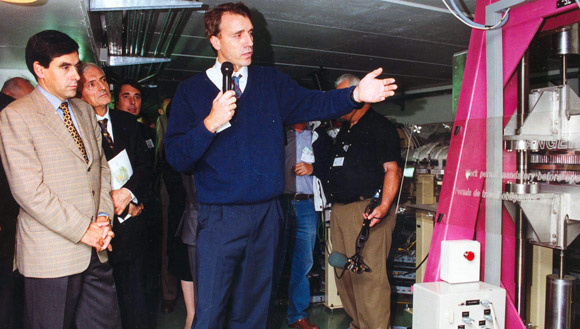- Home
- News
- General News
- The ESRF mourns...
The ESRF mourns Pascal Elleaume
21-03-2011
It is with much grief that we inform everybody that Dr. Pascal Elleaume - Director of the Accelerator and Source Division (ASD) of the ESRF - was killed in an accident last Saturday, 19 March 2011. He was 55 years old. Pascal is survived by his wife Hélène and his children Nicolas, Olivier and Camille. All our thoughts go to Pascal's family.
Share
Dear Friends of Pascal Elleaume, ESRF Colleagues and Users,
It is with much grief that we inform you that Dr. Pascal Elleaume - Director of the Accelerator and Source Division (ASD) of the ESRF - was killed in an accident last Saturday, 19 March 2011. He was 55 years old. Pascal is survived by his wife Hélène and his children Nicolas, Olivier and Camille. All our thoughts go to Pascal's family.
Pascal had just completed a full ten-year cycle directing the ASD at the ESRF. He distinguished himself by his numerous outstanding contributions in the development of storage ring based synchrotron radiation.
At the ESRF since 1986, Pascal was a freshly graduated PhD student when Jean Louis Laclare, the ESRF Project Director, hired him as one of the first ESRF young scientists. His thesis work had been centred on the pioneering observation and interpretation of free-electron laser (FEL) radiation at the LURE, under the guidance of Y. Farge and Y. Petroff.
Pascal created the ESRF Insertion Devices Group, which has been responsible for the world’s most successful design, construction and commissioning of undulators for synchrotron radiation. More than 100 beamline-tailored insertion devices, which can be independently set with no mutual interference, are operational today on the ESRF’s storage ring. Many of them are unique in their design and performance.
As Director of the ASD he has guaranteed over the last 10 years the indisputable worldwide leadership of the ESRF in terms of brightness, reliability, availability and service to users. The ESRF, since its revolutionary initial performances at the on-time/on-budget/on-specification inauguration in 1994, has increased its performances by a factor of ten thousand with respect to its initial design parameters and within the initially foreseen accelerator maintenance budget, to the full benefit of its Users. A factor of one thousand has been accomplished during the last 10 years, under Pascal’s leadership.
 |
|
Pascal Elleaume explaining an undulator to François Fillon (left), then the French minister of research, at the ESRF inauguration ceremony on 30 September 1994. In the background, Michel Destot. |
These days, in the full swing of the ESRF Upgrade Programme, the ESRF ASD is again setting the standards for the next 20 years in the field of synchrotron radiation, with major new technical developments planned and/or already accomplished, such as the new orbit feedback systems and sharply decreased vertical emittance, 6 metre and 7 metre ID NEG coated chambers, ID canting, 300 mA operation, new RF powering systems, new HOM-damped RF cavities, new insertion devices, and optimization of electrical power consumption. All of this will lead to even higher brightness, reliability and availability of the ESRF Source for the benefit of the ESRF Users, and of all synchrotron radiation sources in the ESRF Member Countries and throughout the world.
All this has been, and will be, possible thanks to the outstanding contributions and leadership of Pascal. His great knowledge of accelerator physics and electro-dynamics in general, and his unique experimental skills, have allowed him to integrate the outstanding work of his collaborators, where many different cutting-edge contributions converge in an almost perfect design for new and unprecedented performances. In this way the groups under Pascal's guidance - which operate the accelerators, control the radio-frequency systems, power the storage ring magnets, construct the insertion devices, monitor and control the machine ultra-high vacuum, monitor and control the orbit, study and improve the storage ring lattice, ensure the delivery of the insertion device and bending magnet synchrotron radiation to the beamlines through the front-ends, and ensure the full operation of the ESRF’s accelerator complex - have been able to provide the world-leading performance of the ESRF source to its Users.
All of us at the ESRF, as well as the whole synchrotron radiation community worldwide, are profoundly indebted to Pascal Elleaume: he is one of the rare people whose contributions have completely changed the worldwide scene of synchrotron radiation. His work has contributed tremendously to demonstrate the qualitative difference between second and third generation synchrotron sources, and in establishing the ubiquitous presence of synchrotron radiation in modern science.
I spoke at length with Pascal last Friday, 18 March, and we were making many exciting plans for the implementation of the Upgrade Programme but also to boost the research programme on "Ultimate Storage Ring" sources, and to attract young students to this field that today presents exciting opportunities related to many new technical developments. During the two preceding days we had visited the storage ring tunnel and control room whilst welcoming important visitors. None of us could have thought that this would be the last visit together of "his" machine.
Everyone at the ESRF will miss Pascal Elleaume enormously. All of us at the ESRF send our warmest thoughts and most sincere sympathy to Pascal's family.
Francesco Sette
Director General



